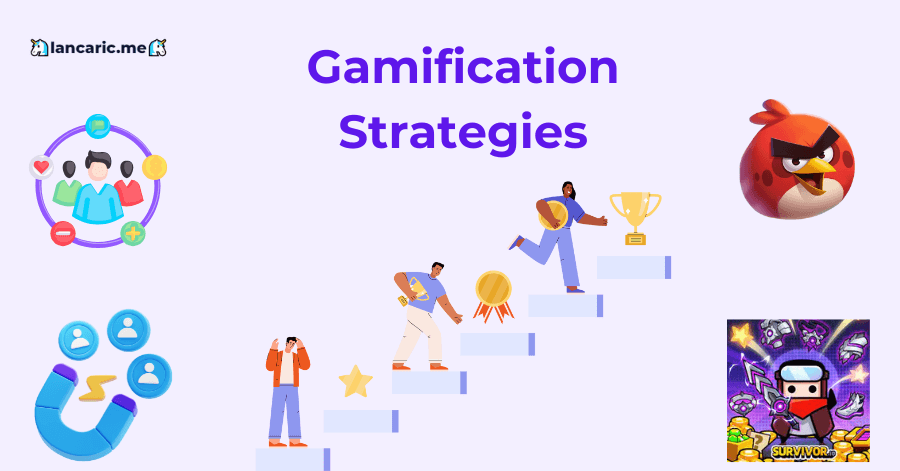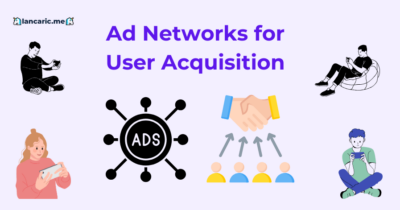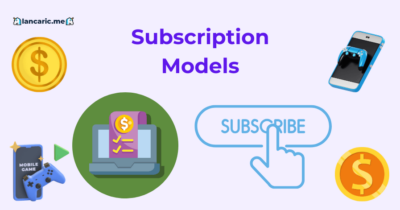
Gamification Strategies for User Retention: Benefits & Tips
Helping you stay 2.5 steps ahead of the games industry. Don't be too serious, except about UA.
Subscribe to my Brutally Honest newsletter!
Gamification strategies include various techniques to keep mobile games players engaged and motivated over time. The gamification strategies aim to create enjoyable and rewarding experiences to encourage players to return regularly and invest more in the game. By integrating elements like rewards, progression systems and social interaction, gamification helps establish habits, emotional connections and a sense of accomplishment for users. The combination of intrinsic and extrinsic motivators ensures that players are consistently engaged.
Key benefits of gamification strategies for user retention include engaging users, enhancing experience, motivating participation, strengthening connections and encouraging continued use. The role of gamification in user acquisition includes simplifying learning, encouraging exploration, increasing motivation, boosting engagement and reinforcing key actions.
Gamification strategies for mobile game user retention include daily rewards and streak systems for habit-building, progression and leveling systems to drive engagement, achievement badges and leaderboards for competitive motivation, personalization and character customization for player connection, social interaction and cooperative play to foster community, limited-time events and challenges for timely excitement, story progression and episodic content to maintain curiosity, rewarded ads and in-game bonuses for an enhanced experience and in-game economy and virtual currency to deepen the gameplay. Examples of successful gamification strategies for user retention in mobile games include Clash of Clans’s daily rewards, Candy Crush’s daily rewards, PUBG Mobile leaderboards and badges, Fortnite leaderboards and badges, Subway Surfers rewarded ads and Temple Run rewarded ads.
Tips for gamification strategies for user retention include defining clear objectives, rewarding user milestones, incorporating progress tracking, fostering competition and collaboration, personalizing the user experience, simplifying gamification elements and refreshing rewards and challenges.
This guide provides you a comprehensive overview of effective gamification strategies, covering the role of gamification in user acquisition, benefits for user retention, practical tips on gamification strategies for user retention and successful examples of gamification strategies.
What Are the Gamification Strategies for Mobile Game User Retention?
Gamification strategies for mobile game user retention include daily rewards and streak systems for habit-building, progression and leveling systems to drive engagement, achievement badges and leaderboards for competitive motivation, personalization and character customization for player connection, social interaction and cooperative play to foster community, limited-time events and challenges for timely excitement, story progression and episodic content to maintain curiosity, rewarded ads and in-game bonuses for an enhanced experience and in-game economy and virtual currency to deepen the gameplay.
Following are the details of each gamification strategy for mobile user acquisition:
Daily Rewards and Streak Systems for Habit-Building
Daily rewards and streak systems foster habit-building by providing players with incentives for consistent engagement. Players receive rewards for logging in daily which encourages routine interaction with the game. Maintaining a streak adds an additional layer of motivation as consecutive logins yield progressively better rewards. The anticipation of daily rewards creates a sense of excitement reinforcing the habit of returning regularly. Streak systems transform player behavior into habitual actions which contribute to sustained engagement.
Daily rewards and streak systems help user retention by promoting consistent gameplay through habit formation. Habit formation is driven by the desire to maintain streaks which provides players with a sense of accomplishment. A sense of accomplishment motivates players to return daily to continue their progress and earn rewards. Daily rewards create positive reinforcement which strengthens players’ emotional attachment to the game. Emotional attachment makes players more invested. The progressively increasing rewards offered by streak systems add an element of progression to keep players interested. Daily rewards and streak systems effectively combine habit-building incentives with consistent engagement to enhance user retention.
Progression and Leveling Systems to Drive Engagement
Progression and leveling systems drive engagement by giving players a clear path of growth and development. Players advance through levels by completing in-game tasks and challenges which provides a sense of accomplishment. Each level unlocks new abilities, rewards or content which adds excitement and motivates play. The visible progress serves as positive reinforcement to encourage players to invest more time in the game. Leveling systems create an environment where players feel that their efforts are consistently rewarded.
Progression and leveling systems help user retention by providing structured milestones that keep players motivated. Structured milestones give players clear goals which direct their focus and maintain interest. The feeling of progression motivates players to continue working towards higher levels and new rewards. Higher levels unlock advanced content which keeps the gameplay experience fresh and engaging. Fresh content reduces the likelihood of players losing interest. Consistent engagement strengthens emotional bonds with the game which makes players more likely to return regularly. Progression and leveling systems effectively create a continuous cycle of effort, reward, and advancement that sustains user retention.
Achievement Badges and Leaderboards for Competitive Motivation
Achievement badges and leaderboards drive competitive motivation by providing players with visible markers of success. Badges serve as symbols of accomplishment and reward players for reaching specific milestones. Leaderboards rank players based on their performance to foster a sense of competition. Competition motivates players to improve their skills to earn higher rankings and achievements. The combination of badges and leaderboards creates an environment where players strive for recognition and status.
Achievement badges and leaderboards help user retention by encouraging continuous effort and improvement. Visible markers of success give players a sense of achievement which boosts their confidence. Increased confidence motivates players to keep pushing their limits to earn more badges and climb the leaderboards. Climbing the leaderboards fosters a sense of progression which contributes to player satisfaction. Satisfaction derived from achievement and competition strengthens emotional attachment to the game. Emotional attachment makes players more likely to return frequently to maintain or improve their status. Achievement badges and leaderboards effectively create a feedback loop of competition, reward and progression that sustains long-term user engagement.
Personalization and Character Customization for Player Connection
Personalization and character customization foster player connection by allowing users to create a unique identity within the game. Customization options such as appearance, outfits and abilities empower players to express themselves. Self-expression strengthens players’ emotional attachment to their characters. Enhanced immersion makes the game experience more meaningful as players feel represented in the virtual world. Meaningful representation motivates players to invest more time and effort in developing their characters.
Personalization and character customization help user retention by making the game experience deeply personal and engaging. A personalized experience gives players a sense of ownership which increases their emotional investment in the game. Emotional investment encourages players to return frequently as they feel connected to their customized characters. Frequent returns foster consistent gameplay which allows players to further evolve and enhance their characters. The evolution of characters provides a sense of progression which boosts player satisfaction. Player satisfaction enhances loyalty which makes players more likely to stay engaged long-term. Personalization and customization effectively create a bond between players and their virtual avatars.
Social Interaction and Cooperative Play to Foster Community
Social interaction and cooperative play foster community by encouraging players to connect with each other. Cooperative play requires teamwork which builds trust and camaraderie among participants. Trust and camaraderie enhance the social dynamics within the game which makes the experience more engaging. An engaging social experience motivates players to form friendships. The sense of belonging created through cooperative activities keeps players involved and contributes to a positive game environment.
Social interaction and cooperative play help user retention by creating a sense of community that encourages players to stay. A strong community offers emotional support which enhances the gaming experience. Emotional support motivates players to return regularly as they feel valued within the group. Regular returns foster consistent engagement which allows players to become integral members of the community. Integral membership leads to deeper emotional bonds. Cooperative challenges and shared goals add excitement and purpose which increases players’ commitment to the game. Social interaction and cooperative play effectively create an environment where players feel connected, supported and motivated to keep playing.
Limited-Time Events and Challenges for Timely Excitement
Limited-time events and challenges create timely excitement by offering exclusive content that is only available for a short period. The limited availability encourages players to engage immediately to avoid missing out on rewards. These events feature unique gameplay mechanics or rewards which add variety to the gaming experience. The sense of urgency associated with limited-time challenges heightens excitement which drives players to participate actively. Exclusive content fosters a feeling of privilege among players.
Limited-time events and challenges help user retention by tapping into the fear of missing out (FOMO) which motivates immediate participation. Immediate participation ensures that players remain actively engaged with the game, even outside regular gameplay routines. Active engagement during these events strengthens players’ connection to the game. A stronger connection fosters emotional attachment which makes players more likely to return for future events. The exclusive rewards offered during limited-time events add value to participation which increases satisfaction. Satisfaction with these events encourages players to stay involved in the long term. Limited-time events effectively blend urgency, exclusive rewards and unique challenges to keep players excited and committed to the game.
Story Progression and Episodic Content to Maintain Curiosity
Story progression and episodic content maintain player curiosity by unfolding the narrative gradually. Each episode introduces new challenges, characters or plot twists that keep players intrigued. Intriguing story elements drive players to continue playing to uncover more of the storyline. The gradual unfolding of content offers a structured experience which prevents players from becoming overwhelmed. Episodic progression encourages a regular schedule of gameplay which ensures players remain connected to the storyline.
Story progression and episodic content help user retention by creating a sense of anticipation for the next episode. Anticipation motivates players to return to the game to continue the storyline to maintain consistent engagement. Consistent engagement keeps players involved with the evolving narrative and enhances their emotional investment. Emotional investment builds a strong connection to the characters and the storyline which encourages loyalty. Loyalty ensures that players are more likely to participate in events and challenges related to the story. Participation in story-related events provides additional rewards and content. Story progression effectively combines anticipation, narrative development and episodic structure to foster curiosity and sustain user retention.
Rewarded Ads and In-Game Bonuses for Enhanced Experience
Rewarded ads and in-game bonuses enhance the gaming experience by offering players incentives for engagement. Players watch ads to receive in-game bonuses such as extra lives, currency or power-ups. The rewards provide immediate value which makes players more inclined to participate. Immediate rewards create a sense of gratification by adding enjoyment to the gameplay. The integration of rewarded ads seamlessly ties monetization with enhancing player experience.
Rewarded ads and in-game bonuses help user retention by aligning incentives with active gameplay. Players receive bonuses that facilitate in-game progression and motivate them to continue engaging with the content. Progression supported by in-game bonuses makes difficult levels or challenges more manageable which reduces frustration. Reduced frustration increases player satisfaction and creates a positive experience. A positive experience fosters an emotional connection to the game. Frequent engagement allows players to continuously unlock bonuses and form a cycle of motivation and reward. The use of rewarded ads to provide in-game bonuses keeps players engaged, invested and excited to return.
In-Game Economy and Virtual Currency to Deepen Gameplay
In-game economy and virtual currency are used to deepen gameplay by creating an immersive economic system within the game. Players earn virtual currency through in-game activities which allow them to purchase items or upgrades. The purchases enhance personalization and give players more control over their gaming experience. The sense of control and progression enriches gameplay which provides more depth to player engagement. Virtual currency adds a layer of strategic decision-making which encourages players to allocate resources wisely.
An in-game economy with virtual currency helps user retention by offering continuous incentives for active participation. Earning virtual currency motivates players to keep playing as progression depends on accumulating these resources. Accumulation of currency allows players to unlock exclusive items. Achievement fosters satisfaction and enhances the player’s emotional connection to the game. A strong emotional connection encourages players to return frequently. Consistent engagement results in the exploration of additional game features. An effective in-game economy with virtual currency creates a cycle of earning, spending and progression that keeps players invested and eager to return.
What Is the Role of Gamification in User Acquisition?
The role of gamification in user acquisition includes simplifying learning, encouraging exploration, increasing motivation, boosting engagement and reinforcing key actions.
Gamification plays a crucial role in user acquisition by providing interactive and engaging experiences that attract new players to mobile games or apps. Elements such as rewards, challenges and leaderboards create a sense of excitement to encourage users to explore and engage with the platform. User acquisition strategies that incorporate gamification tend to perform better by drawing in users with incentives like progress bars, achievements or exclusive content. The gamified onboarding process makes learning how to use the app enjoyable by reducing barriers to entry and increasing conversion rates. User acquisition benefits greatly from gamification when users feel a sense of achievement or competition right from the start. By integrating game elements like points, badges and competitions into marketing campaigns, developers attract players who seek interactive experiences.
The following is the detail of each role of gamification in user acquisition:
Simplifies Learning
Simplifying learning refers to breaking down complex concepts into manageable tasks. Manageable tasks help users gradually understand features by reducing the cognitive load associated with learning. Reduced cognitive load enhances user comfort and makes the learning process more enjoyable. An enjoyable learning process motivates users to engage with new elements and reinforces the retention of information. Retention of information builds user confidence which encourages continued interaction with the product. Continued interaction helps users master more advanced features. Gamification leverages step-by-step progression and rewards to simplify learning and make the process more engaging and less daunting.
Encourages Exploration
Encouraging exploration refer to offering incentives like rewards, achievements or quests which prompt players to discover new areas, features or content within the game to enhance engagement and create a more immersive experience. Challenges create opportunities for users to engage with different features. A sense of discovery motivates players to explore new areas and unlock hidden content. Unlocking hidden content provides rewards that reinforce positive behavior and encourage exploration. Further exploration enhances familiarity with the product which leads to deeper user engagement. Deeper engagement strengthens user confidence by making them more comfortable with navigating various aspects of the product. Gamification effectively uses curiosity-driven challenges and rewards to encourage exploration which contributes to a richer user experience.
Increases Motivation
Gamification in user acquisition increases motivation by offering meaningful rewards that incentivize user actions. Rewards such as points, badges or virtual goods create a sense of achievement which enhances users’ desire to participate. A sense of achievement drives positive reinforcement which motivates users to repeat desired behaviors. Repeated behaviors strengthen the association between effort and reward by making engagement more appealing. Increased appeal encourages users to explore new features which deepen their connection to the product. A deeper connection fosters a sense of progress which fuels motivation to achieve new milestones. Gamification strategies that align rewards with user effort effectively increase motivation which contributes to sustained user involvement.
Boosts Engagement
Gamification in user acquisition boosts engagement by incorporating interactive and rewarding elements that captivate users. Interactive elements such as challenges or missions encourage users to actively participate and create a more immersive experience. An immersive experience fosters deeper emotional investment which drives ongoing interaction. Ongoing interaction increases the likelihood of users exploring more features by enhancing their familiarity with the product. Familiarity builds user confidence which encourages participation and repeated engagement. Repeated engagement establishes strong user habits which contribute to product loyalty. Gamification effectively combines interaction, rewards and progression to boost user engagement and sustain interest in the product.
Reinforces Key Actions
Gamification in user acquisition reinforces key actions by providing incentives that encourage desired behaviors. Incentives such as rewards or badges drive users to complete specific tasks which align with acquisition goals. Completing tasks reinforces learning and enables users to become proficient with product features. Proficiency increases confidence and motivates users to perform more key actions. Key actions, when consistently repeated solidify behavior patterns that contribute to effective user acquisition. Solidified behavior patterns lead to higher engagement rates which directly impact user growth. Gamification elements that provide incentives for key actions create a structured path that encourages users to continue interacting with the product.
What Are the Benefits of Gamification Strategies for User Retention?
Key benefits of gamification strategies for user retention include engaging users, enhancing experience, motivating participation, strengthening connections and encouraging continued use.
By implementing game-like features such as challenges, achievements and rewards, players feel motivated to continue their engagement which increases the likelihood of staying active over a longer period. User retention improves when users feel a sense of accomplishment and progression which is effectively delivered through well-crafted gamified elements. Maintaining user interest through engaging content and challenges leads to greater satisfaction and reduces the likelihood of churn. By keeping users engaged through rewards and recognition, gamification creates an emotional bond that encourages consistent interaction.
Here’s the detail of the key benefits of gamification strategies for user retention:
Engages Users
Engaging users involves capturing and maintaining their attention through meaningful interactions with a product or service. Gamification strategies engage users by incorporating interactive tasks and challenges that stimulate interest. Interest motivates players to actively participate and enhance their connection to the game. Active participation fosters a deeper understanding of game mechanics which contributes to increased proficiency. Increased proficiency leads to a sense of mastery by engaging players. A sense of mastery encourages users to set new goals by driving continuous involvement. Continuous involvement strengthens emotional ties to the game and promotes ongoing interaction. Gamification strategies that blend interactivity, challenges and goal-setting effectively engage users.
Enhances Experience
Experience is the cumulative perception and emotional response of users when interacting with a product or service. Gamification strategies enhance the experience by adding interactive and rewarding elements that make gameplay enjoyable. Enjoyable gameplay fosters player satisfaction which increases emotional investment in the game. Emotional investment drives consistent engagement as players seek to maintain their connection to the positive experience. Consistent engagement allows players to fully explore game features and enhance their sense of progression. A sense of progression leads to higher levels of achievement. Increased satisfaction encourages players to continue interacting with the game which results in greater retention. Gamification strategies that incorporate rewards, progression and interactivity create an enriched experience that keeps users returning.
Motivates Participation
Motivates participation by offering rewards, badges and achievements that encourage players to engage actively with the game to create a sense of accomplishment and progression. Rewards create a tangible goal which encourages players to take specific actions within the game. Specific actions help players progress by fostering a sense of accomplishment. A sense of accomplishment enhances player satisfaction which drives engagement. Increased engagement motivates players to set higher personal goals by pushing them to participate even more actively. Active participation leads to greater skill development and reinforces their interest in the game. Gamification elements that align rewards with progression effectively motivate users to continuously participate, supporting long-term retention.
Strengthens Connections
Strengthens connections by fostering a sense of community and interaction among players through cooperative features, social challenges and multiplayer elements. Social interactions encourage players to form bonds and create a sense of community. A sense of community increases player belonging which enhances their experience. Enhanced experience motivates users to engage more deeply with the game and its community. Deeper engagement leads to collaborative gameplay and promotes cooperation and shared goals. Shared goals strengthen teamwork which positively impacts player loyalty. Strengthened connections through social interaction and teamwork contribute to higher user retention as players feel more committed to both the game and their fellow players.
Encourages Continued Use
Encourage continued use by integrating rewarding elements that keep players motivated. Rewards such as points or badges create a tangible sense of accomplishment. Accomplishment increases player satisfaction which strengthens their emotional connection to the game. A strong emotional connection motivates players to return frequently and foster habitual use. Habitual use leads to consistent gameplay which enhances player skill and progression. Enhanced progression drives motivation to engage while establishing a positive feedback loop. Gamification strategies that incorporate rewards and progression create an engaging experience that encourages players to continue using the platform.
What Are the Tips for Gamification Strategies for User Retention?
Tips for gamification strategies for user retention include defining clear objectives, rewarding user milestones, incorporating progress tracking, fostering competition and collaboration, personalizing the user experience, simplifying gamification elements and refreshing rewards and challenges.
Here are the details of each tip for gamification strategies for user retention:
Define Clear Objectives
Clear objectives are specific, well-defined goals that guide player actions within a game. Defining clear objectives helps gamification strategies for user retention by providing players with a clear sense of direction. A clear sense of direction minimizes confusion and allows players to focus on meaningful tasks. Meaningful tasks enhance player motivation and encourage consistent engagement with the game. Consistent engagement reinforces the player’s commitment to achieving the set objectives and drives a sense of progression. A sense of progression leads to greater satisfaction which directly impacts player loyalty. Increased loyalty contributes to higher retention rates as players are more likely to continue participating. Defining clear objectives creates a structured and rewarding gameplay experience that keeps players coming back.
Reward User Milestones
User milestones are significant achievements or stages that players reach during gameplay. Rewarding user milestones enhances gamification strategies for user retention by recognizing and celebrating player achievements. Recognition provides players with a sense of accomplishment and reinforces their progression within the game. Reinforced progression motivates players to continue pursuing milestones which drives consistent gameplay. Consistent gameplay increases player engagement and fosters loyalty and commitment to the game. Rewards such as in-game items or special privileges add value to the player’s experience and encourage future participation. Increased participation strengthens the player’s emotional connection to the game which enhances retention. Rewarding user milestones effectively combines recognition and tangible rewards.
Incorporate Progress Tracking
Progress tracking is the process of monitoring and visualizing a player’s advancement through different game stages. Incorporating progress tracking helps gamification strategies for user retention by providing clear goals and milestones. Clear goals give players direction which fosters a sense of purpose while engaging with the game. A sense of purpose motivates players to continue their efforts which enhances their in-game progression. Progression visualization such as levels or achievements reinforces a player’s sense of accomplishment. A sense of accomplishment leads to increased player satisfaction which boosts loyalty. Loyalty encourages players to invest more time in the game which enhances retention.
Foster Competition and Collaboration
Competition and collaboration are fundamental elements of gamification used to engage and retain players. Fostering competition and collaboration effectively enhances gamification strategies for user retention. Competition motivates players to outperform others and generates a sense of challenge and excitement. Excitement encourages continued gameplay and fosters consistent engagement with the game. Collaboration builds a sense of community by allowing players to work together towards common goals. A strong community encourages positive social interaction which contributes to user satisfaction. Satisfaction gained through competition and collaboration drives loyalty which leads to sustained user participation. The combination of competitive and cooperative dynamics creates a balanced experience and promotes long-term user retention.
Personalize User Experience
User experience is the perception and response of users when interacting with a product or service. Personalizing user experience tailors game content to individual player preferences which enhance their sense of relevance. A relevant experience resonates with players which increases emotional connection and satisfaction. Increased satisfaction encourages users to engage with the game more frequently. Frequent engagement fosters loyalty which directly contributes to user retention. Loyalty leads players to invest more time and effort which enhances their progression. Enhanced progression creates a sense of achievement and motivates players to continue engaging.
Simplify Gamification Elements
Gamification elements are features designed to enhance user engagement through game-like experiences. Simplifying gamification elements reduces complexity and makes the user experience more intuitive. An intuitive experience decreases cognitive load by allowing players to focus on enjoyment. Enjoyment drives users to participate more frequently which increases engagement. Increased engagement fosters consistent user interaction with the platform. Consistent interaction leads to a sense of achievement. Enhanced satisfaction motivates users to continue participating and contribute to higher retention. Simplified gamification elements effectively create an accessible and enjoyable experience that supports sustained user retention.
Refresh Rewards and Challenges
Refreshing rewards and challenges serve as a vital gamification strategy to improve user retention. Refreshing rewards introduce new incentives periodically which helps sustain player interest. Sustained interest encourages players to re-engage with the game more frequently. Frequent re-engagement motivates users to complete newly introduced challenges to earn rewards. Completing challenges provides a sense of progression and reinforces player satisfaction. Player satisfaction enhances the motivation to continue participating in future challenges. The cycle of refreshing rewards and challenges forms a dynamic retention strategy that maintains engagement and fosters long-term loyalty among players.
What Are the Examples of Successful Gamification Strategies for User Retention in Mobile Games?
Examples of successful gamification strategies for user retention in mobile games include Clash of Clans’s daily rewards, Candy Crush’s daily rewards, PUBG Mobile leaderboards and badges, Fortnite leaderboards and badges, Subway Surfers rewarded ads and Temple Run rewarded ads.
Let’s discuss each example of successful gamification strategies for user retention in mobile games in detail:
Clash of Clan’s Daily Rewards
Clash of Clans incorporates daily rewards as an effective gamification strategy to enhance user retention. Daily rewards incentivize players to log in regularly which establishes a routine that fosters habitual gameplay. Habitual gameplay increases player engagement by offering progression-based incentives. Progression-based incentives include resources like gems, gold or elixir which support in-game growth. In-game growth motivates players to consistently participate in battles and upgrade their villages. Consistent participation enhances players’ sense of achievement which directly impacts user satisfaction. The daily rewards mechanism effectively combines routine engagement with progression and creates a sustainable model for long-term player retention and loyalty.
Candy Crush’s Daily Rewards
Candy Crush uses daily rewards as an effective gamification technique to boost user retention. Daily rewards provide players with incentives for logging in consecutively by creating a habit-forming behavior. Habitual engagement fosters a sense of consistency which encourages regular play. Consistent daily play grants players rewards such as boosters, extra lives or in-game currency. The rewards motivate players to keep returning to maximize their benefits. Maximizing benefits results in increased gameplay frequency which directly contributes to user retention. Daily rewards help sustain user interest by combining in-game progression with consistent engagement incentives and enhancing enjoyment and loyalty.
PubG Mobile Leaderboards and Badges
PubG Mobile utilizes leaderboards and badges as effective gamification tools to promote user retention. Leaderboards rank players based on their in-game achievements by cultivating a competitive atmosphere. The competition motivates players to enhance their gameplay to secure higher rankings. Higher rankings reward players with badges that represent prestige within the gaming community. Prestige drives players to maintain consistent engagement to showcase their status. Consistent engagement results in higher in-game activity which directly contributes to user retention. The combined effect of leaderboards and badges creates a sustainable gamification model that encourages continued player participation and builds community loyalty.
Fortnite Leaderboards and Badges
Fortnite successfully employs leaderboards and badges as gamification techniques to enhance user retention. Leaderboards rank players based on their performance by fostering a sense of competition among users. The competitive environment encourages players to improve their skills to achieve higher rankings. High rankings reward players with badges which serve as status symbols within the community. Status symbols motivate users to consistently participate and strive for recognition and prestige. Recognition and competition drive players to spend more time in-game which results in prolonged engagement. The interplay of leaderboards and badges forms a dynamic gamification strategy that strengthens user commitment and fosters long-term retention.
Subway Surfers Rewarded Ads
Subway Surfers effectively uses rewarded ads as a successful gamification strategy to enhance user retention. Rewarded ads provide players with incentives such as extra coins or power-ups upon watching an advertisement. Players seeking in-game rewards actively choose to engage with ads. The interaction between players and rewarded ads increases in-game progression which positively impacts player satisfaction. Increased satisfaction motivates players to continue engaging with the game regularly. The combination of ad engagement and rewards facilitates sustained retention by merging enjoyment with external incentives. Rewarded ads contribute to a balanced gamification approach which drives user engagement and monetization.
Temple Run Rewarded Ads
Temple Run uses rewarded ads as a gamification strategy to enhance user retention effectively. Rewarded ads offer players in-game incentives like coins or power-ups in exchange for watching advertisements. The in-game incentives enhance player motivation and encourage users to engage longer. Extended engagement fosters positive user sentiment towards the game’s monetization model which makes users feel rewarded instead of intrusively targeted. The rewarding mechanism generates higher ad-view rates which subsequently increases ad revenue. Higher ad revenue supports game updates which helps maintain player interest through new content. Consistent new content solidifies user retention by preventing monotony.
What Is the Difference Between Intrinsic and Extrinsic Motivation in Gamification?
The main difference between intrinsic and extrinsic motivation in gamification is that intrinsic motivation comes from internal enjoyment of the activity while extrinsic motivation relies on external rewards like points or badges. Intrinsic motivation drives players through personal satisfaction, curiosity and accomplishment. Players are engaged by intrinsic motivation to find meaning and purpose in-game activities which promotes deeper engagement. Extrinsic motivation uses external incentives such as rewards, leaderboards or achievements to encourage player behavior. Relying solely on extrinsic motivation leads to temporary engagement whereas intrinsic motivation tends to foster long-term commitment.
Helping you stay 2.5 steps ahead of the games industry. Don't be too serious, except about UA.
Subscribe to my Brutally Honest newsletter!









